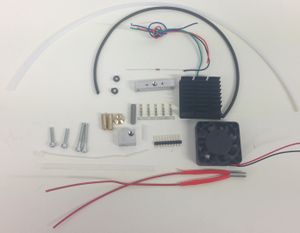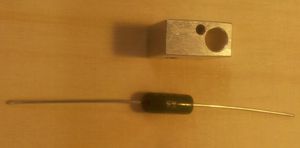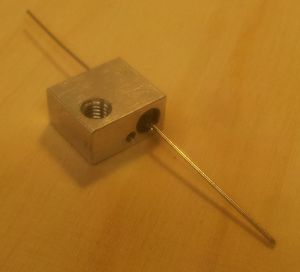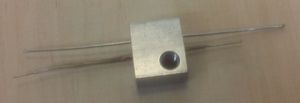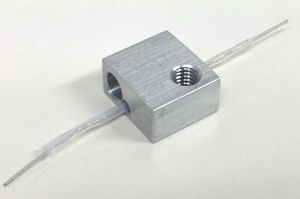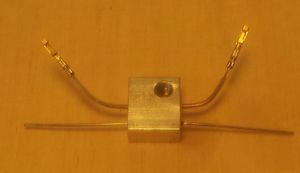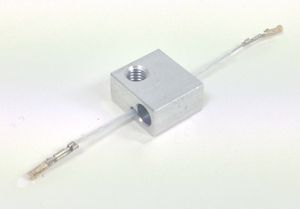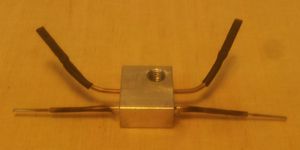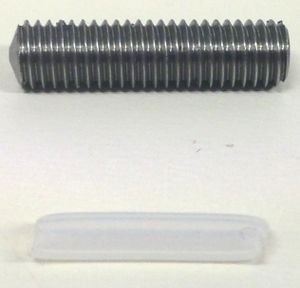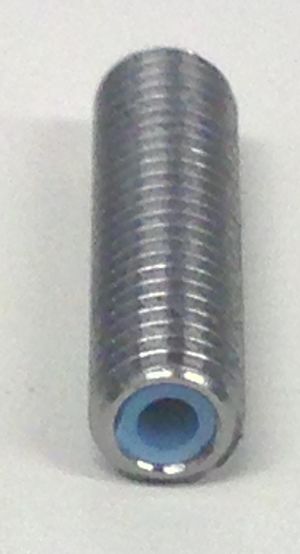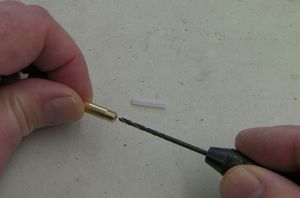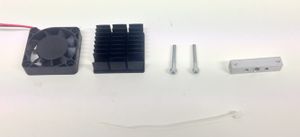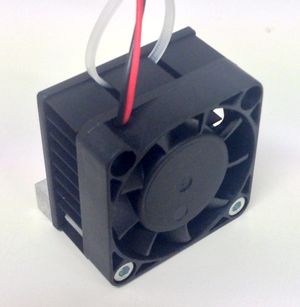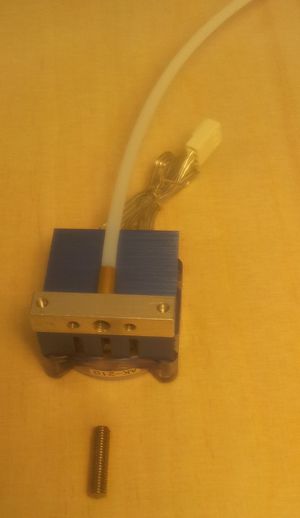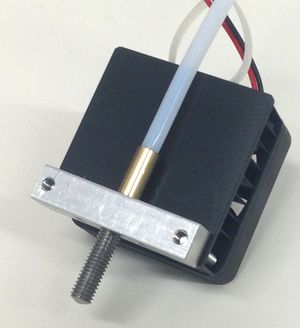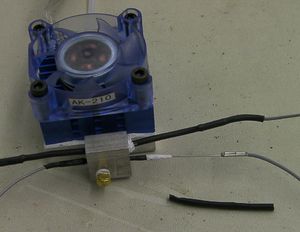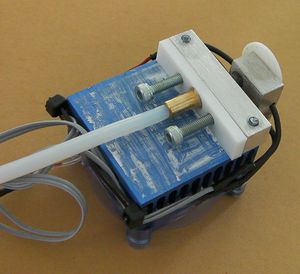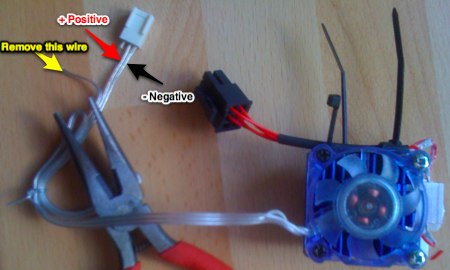Template:RepRapPro hot end assembly
Contents
Tools
You will need the following tools:
- Allen key
- Small screwdriver
- Pliers
- Adjustable spanner
- Heat sources (small blowtorch plus hairdryer/soldering-iron)
- Bench vice
Parts
The Huxley heating resistor is a 6R8, whereas the Mendel one is 2R7.
There are several stages in this construction where you have to trim pieces of PTFE. It is essential to clear any swarf created away and not to let it get into the extruder. PTFE swarf will travel to the nozzle and block it if it is allowed to contaminate the device.
Step 1: The hot part of the hot end
Check that the heater resistor fits in the larger hole in the heater block. The resistors can be a little variable in their diameter. The thermistor should fit in its hole - they are manufactured to a tighter tolerance.
If the resistor is too big, clamp the heater block firmly in a vice and run a 5mm drill down it. Be careful to run it square on. Running the drill up and down will shave a little off the sides of the hole. Repeat this until the resistor fits. The ideal fit is if it is snug, but not tight. You should only need light force to put it in its hole. If you have to push it hard, this will damage its insulation.
If the resistor is too small in the hole, wrap enough Aluminium foil around the body of the resistor to ensure a tight fit in the hole. Ensure that the resistor leads do not contact the Aluminium foil.
Next you will fit the thermistor. For this step, you will need the axial thermistor, and length of PTFE (clear) heatshrink.
Cut the PTFE heatshrink such that when slid over the thermistor, approximately 5mm of the leads are bare at each end. With the PTFE heatshrink in position, use a heat source to shrink the PTFE around the thermistor bead and leads. PTFE heatshrink requires temperatures in excess of 300C to shrink. A naked flame will do for this. Keep the flame moving whilst shrinking the PTFE.
Take the sheathed thermistor, and slide one lead into the small hole in the heater block. With the thermistor bead up to the side of the heater block, the PTFE heatshrink should protrude form the other side of the block. Grasp the PTFE heatshrink with some pliers, and pull the thermistor through until the bead is roughly in the centre of the heater block.
Next you will terminate the resistor and thermistor leads. Crimp terminals onto the ends of the thermistor leads, then sheath those terminals using black Polyolefin heatshrink.
Finally, sheath the resistor leads using PTFE heatshrink
Set the heater block aside for use in a minute.
We will need a short length (about 10mm) of 3mm diameter PTFE tube to line the cold end of the one-piece nozzle.
Using a sharp blade, cut one end of the PTFE liner. Try to make the cut as square to the axis of the tube as possible. Push this into the counter-bore at the cold end of the one-piece nozzle. Again using a sharp blade, cut the PTFE liner flush with the cold end of the one-piece nozzle.
Take a 5mm drill and gently twist it against the end of the PTFE that you have just created to dish it slightly. Make sure you clear all swarf away. Now set the one-piece nozzle to one side.
Step 2: The cooling system
Now you will assemble the cooling system.
Take the free end of the extruder drive's PTFE tube. Use a pencil sharpener to make a small cone on about 2mm of the free end of the 4mm tube. Take care not to cut too far - PTFE is very soft.
Using a fine permanent marker pen, draw a line across the tube, 10mm from the end. Screw the brass union onto the free end of the extruder drive's PTFE tube until the brass union almost reaches the line you have drawn. By looking down the other end of the brass you will be able to see that the PTFE has reached the end of the thread (a magnifying glass is useful here).
Screwing the tube in will have reduced its internal diameter slightly. Gently twist a 2mm drill by hand in the end of the brass to thin the tube where it is inside the screw thread. If you have a small hand-chuck this is made easier:
Push a length of 1.75mm build filament down the tube from the other end to clear out any PTFE swarf (see the warning above about leaving any behind). Make sure the filament runs freely down the tube and comes out of the far end without impediment.
Some heatsinks come with a sticky backing which you will need to peel off. This can be quite tough - you may need to pull with pliers. Take care not to put stress on the delicate plastic fan. The easiest way once you have a corner off is to hold that with long-nosed pliers and to roll them over the back face of the heatsink like peeling the lid off a tin of sardines.
You can put a little heatsink grease on the aluminium cooling block if you like. Attach it to the fan with the two longer screws. Feed the screws in through the fan and into the cooling block.
In some fans the mounting holes are stepped partway down: the screw head should sink down into the recess and sit on the step. Depending upon the type of fan you received with your kit you may find that the screw heads are too big to fit into the mounting holes and thus do not reach the cooling block. If this happens, put the screw in the chuck of a drill and grind the head against a piece of coarse aluminum oxide sandpaper or a grinding wheel. Only take off enough to allow the head to sink down to the step. If you take off too much it won't catch securely on the step.
Now screw the brass bowden end piece (with the PTFE bowden tube screwed into it), into the Aluminium heatsink block (the long thin one with five holes in it).
Once fully screwed in, screw the free end of the barrel into the M5 hole in the Aluminium heatsink block until it meets the brass piece. Now unscrew the brass piece by 1/4 turn, screw the barrel in to meet it, and finally tighten the brass piece with some pliers. This will result in the barrel and bowden end pieces being locked together inside the heatsink block.
Step 3: The heater resistor and temperature-measuring thermistor
If the heater resistor is too lose in its hole in the heater block, wrap it in a little PTFE tape. Either way, put some heat-sink grease on it to give good heat contact with the aluminium block. The best heat-sink grease to use is the stuff with titanium dioxide in it - this looks like an artist's tube of white oil paint (for good reason - that also contains TiO2; but don't use paint!).
DO NOT force the heater resistor into the heater block. This may result in some enamel being scraped from either or both ends of the resistor, leading to a short circuit. If the resistor is too large, gradually enlarge the hole using a 5mm drill bit.
Use two adjacent wires from the ribbon cable for each end of the heater resistor - four in all. This is to increase the current capacity.
The wires across the ribbon cable in order go like this:
- Wire with the colour stripe: Thermistor
- Thermistor
- Fan + volts
- Fan Ground
- Heater resistor Wire 1
- Heater resistor Wire 1
- Heater resistor Wire 2
- Heater resistor Wire 2
Resistor wires 1 and 2 are arbitrary - the resistor has no polarity.
This order is designed to keep the heater wires (which experience high current transients) as far as possible from the thermistor wires (which convey the very low current temperature signal to a high-impeedance input).
You can either use the ferrule crimps (right in the red box in the parts picture) or the connector crimps (left). The connector crimps just plug onto the resistor and thermistor wires, which is simple. The ferrule crimps are a bit more fiddly, and they make a permanent connection.
The advantage of the connector crimps is that you can plug and unplug the wires. The advantage of the ferrules is that they give a better quality (i.e. lower resistance) connection.
Alternative 1: Ferrule crimps
The pictures show the ferrule crimps and the single wires.
Bare about 10mm on the end of the resistor connector wires and crimp them onto the ends of the resistor's leads. Put heatshrink on and use a soldering iron or hairdryer to shrink it.
The picture shows the left-hand side complete, and the right hand side waiting for the crimp to be slid over the join followed by crimping. It also shows conventional heatshrink. To shrink the PTFE heatshrink you will have to hit it with a flame - a mere soldering iron won't touch it.
The thermistor should fit in its hole - they are manufactured to a tighter tolerance. It will be a little undersized. But the crimps on the thermistor wires won't fit through the hole, so you have to crimp one wire after the thermistor has been pushed through the block.
Put about 20mm of PTFE heatshrink over the thermistor and shrink it on with a flame (try not to scorch things). Put the thermistor in the block - the PTFE should make it a snug fit. Crimp and then heatshrink over the connections to either end. With the ribbon cable for the second thermistor connection, don't forget to slide the heatshrink onto it and away from the join before you make the join - you won't be able to get it on afterwards.
Alternative 2: crimp sockets
Simply crimp the sockets on the ends of the thermistor and heater resistor wires, then shrink black heatshrink over them to insulate them. Remember that each end of the heater resistor needs two wires - bare them and twist the ends together before fitting the crimp sockets.
This step is easiest with the correct tool, such as this one http://www.rapidonline.com/Tools-Equipment/Ratchet-Action-Crimp-Tool-Ht225d-85-0262 If you do not have such a tool, this advice is worth following http://www.youtube.com/watch?v=KEm2PuHBt4Y
Connecting up
Bend the wires up the side of the heat sink. Do not pull them tight - they need a little slack to accommodate movement and expansion. Attach them at the top of the heatsink with two cable ties chained together, one of them running through the top slot in the heatsink.
Trim the excess off the cable ties.
Use a meter to check that the resistance between the wires and the aluminium block is infinite and that nothing is shorting.
Also check the resistance of the heater resistor and the thermistor by measuring from the far ends of the wires. The Mendel heater should be just under 3 ohms or the Huxley just under 7 ohms. The thermistor should be about 100K.
Step 4: Fan wires and nozzle insulator
You need to cut one wire off the fan. Looking at the picture below, use a red and a black felt-tipped pen to mark the positive and negative fan wires. Trace them right back to the fan and mark them there.
Cut the socket off (leaving your marks on the fan side of the cut...), then remove the extraneous wire.
Screw the PTFE insulating cone onto the nozzle.
